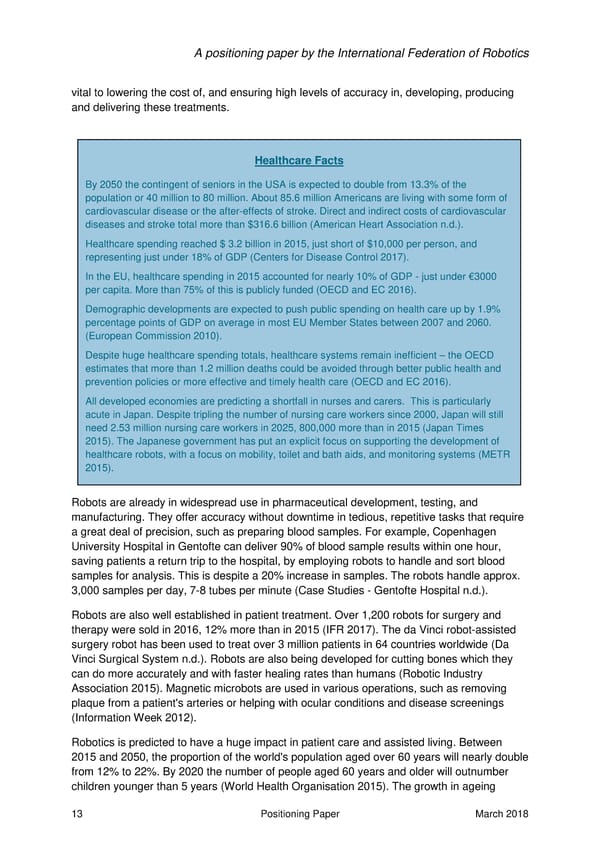A positioning paper by the International Federation of Robotics vital to lowering the cost of, and ensuring high levels of accuracy in, developing, producing and delivering these treatments. Healthcare Facts By 2050 the contingent of seniors in the USA is expected to double from 13.3% of the population or 40 million to 80 million. About 85.6 million Americans are living with some form of cardiovascular disease or the after-effects of stroke. Direct and indirect costs of cardiovascular diseases and stroke total more than $316.6 billion (American Heart Association n.d.). Healthcare spending reached $ 3.2 billion in 2015, just short of $10,000 per person, and representing just under 18% of GDP (Centers for Disease Control 2017). In the EU, healthcare spending in 2015 accounted for nearly 10% of GDP - just under €3000 per capita. More than 75% of this is publicly funded (OECD and EC 2016). Demographic developments are expected to push public spending on health care up by 1.9% percentage points of GDP on average in most EU Member States between 2007 and 2060. (European Commission 2010). Despite huge healthcare spending totals, healthcare systems remain inefficient – the OECD estimates that more than 1.2 million deaths could be avoided through better public health and prevention policies or more effective and timely health care (OECD and EC 2016). All developed economies are predicting a shortfall in nurses and carers. This is particularly acute in Japan. Despite tripling the number of nursing care workers since 2000, Japan will still need 2.53 million nursing care workers in 2025, 800,000 more than in 2015 (Japan Times 2015). The Japanese government has put an explicit focus on supporting the development of healthcare robots, with a focus on mobility, toilet and bath aids, and monitoring systems (METR 2015). Robots are already in widespread use in pharmaceutical development, testing, and manufacturing. They offer accuracy without downtime in tedious, repetitive tasks that require a great deal of precision, such as preparing blood samples. For example, Copenhagen University Hospital in Gentofte can deliver 90% of blood sample results within one hour, saving patients a return trip to the hospital, by employing robots to handle and sort blood samples for analysis. This is despite a 20% increase in samples. The robots handle approx. 3,000 samples per day, 7-8 tubes per minute (Case Studies - Gentofte Hospital n.d.). Robots are also well established in patient treatment. Over 1,200 robots for surgery and therapy were sold in 2016, 12% more than in 2015 (IFR 2017). The da Vinci robot-assisted surgery robot has been used to treat over 3 million patients in 64 countries worldwide (Da Vinci Surgical System n.d.). Robots are also being developed for cutting bones which they can do more accurately and with faster healing rates than humans (Robotic Industry Association 2015). Magnetic microbots are used in various operations, such as removing plaque from a patient's arteries or helping with ocular conditions and disease screenings (Information Week 2012). Robotics is predicted to have a huge impact in patient care and assisted living. Between 2015 and 2050, the proportion of the world's population aged over 60 years will nearly double from 12% to 22%. By 2020 the number of people aged 60 years and older will outnumber children younger than 5 years (World Health Organisation 2015). The growth in ageing 13 Positioning Paper March 2018
 Robots & the Workplace of the Future Page 13 Page 15
Robots & the Workplace of the Future Page 13 Page 15